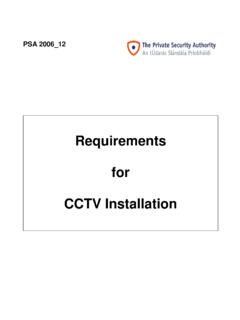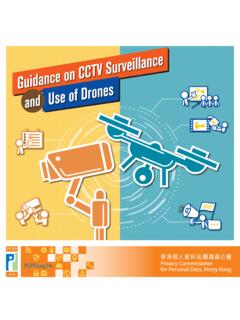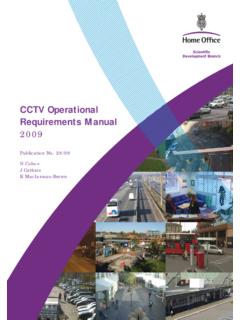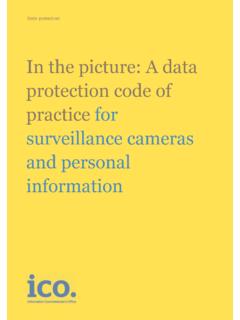Transcription of Requirements for CCTV Installation
1 PSA 2006_12. Requirements for cctv Installation Table of Contents Page No. 1. Introduction ..3. 2. Normative References ..3. 3. Definitions ..4. 4. Overview ..6. 5. Location Survey ..6. 6. System Design ..6. 7. System design 8. Installation Planning ..9. Manufacturer's Environmental considerations ..9. 9. cctv Installation ..9. 10. Test and Inspection ..10. Functional testing ..10. 11. As Fitted Document ..10. 12. Maintenance ..10. 1. Appendices Appendix 1 Flow Chart of cctv installations ..12. Appendix 2 (Informative) Operational Requirements For cctv Systems ..13. Appendix 3 Information to be included in Systems Design Appendix 4 (Informative) Sample Layout for System Design Proposal ..16. Appendix 5 (Informative) Checklist for cctv Installation ..17. Appendix 6 Record of ..19. 2. 1. Introduction The objective of this document is to provide a reference against which Installers of cctv . systems, whether analogue, digital or a combination of these technologies, can be inspected to ensure that the functions and performance of cctv systems installed by them are within levels agreed by the licensed contractor and the client or user of the cctv system during the System Design phase of the process.
2 This document is not a technical reference but sets out the PSA licensing Requirements for the Installation of cctv systems. Its function is to facilitate the licensing process for cctv installers by the Private Security Authority. It is a companion document to the Standard Recommendation 40 (SR40) and any provision, paragraph, clause or sentence within SR40 that is in conflict with this document shall be disregarded. This document has been prepared by the Private Security Authority in consultation with representatives from the private security industry and An Garda S och na. This document may be an interim measure which will be used to underpin the licensing of installers of cctv . systems. When an agreed standard becomes available which is adopted nationally, this document may be superseded and replaced by that standard for cctv Installation . This is a working document and is subject to alteration or withdrawal in consultation with the relevant private security industry stakeholders at the discretion of the Private Security Authority.
3 2. Normative References This document incorporates provisions and extracts from other publications as follows by kind permission of the National Standards Authority of Ireland:- EN 50131-1, Alarm systems Intrusion systems Part 1 General Requirements CLC/TS 50131-7, Alarm systems Intrusion systems Part 7 Application Guidelines EN 50132, Alarm systems cctv surveillance for use in security applications. 3. 3. Definitions cctv system: A system consisting of electronic or other devices designed constructed or adapted to monitor or record images on or in the vicinity of premises. cctv surveillance Installation ( Installation ): An Installation consisting of the hardware and software components of a cctv system, fully installed and operational for monitoring on or in the vicinity of premises. cctv camera (camera): A unit containing an imaging device producing a video signal from an optical image. cctv camera equipment: A unit containing a cctv camera plus appropriate lens and necessary ancillary equipment.
4 Camera housing: An enclosure to provide physical and/or environmental protection of the camera, lens and ancillary equipment. client: The purchaser of the cctv system or representative(s) of the purchaser appointed for the purpose of purchasing the cctv system. data: image, meta and other data of the cctv system. documentation: paperwork (or other media) prepared during the design, Installation and hand over of the cctv system, recording details of the cctv system, including paperwork (or other media) related to maintenance (where applicable). event: incident in the real world. EXAMPLE: A fire (burning house), an intrusion (broken door) or moving person, a power failure, a short circuit, an intruder passing into or into the vicinity of a premises. export: transfer of data from the original location to a secondary storage location with a minimum of necessary changes. fault condition: condition of the system which prevents the cctv system or parts thereof functioning normally.
5 Frame rate: numbers of frames per second. illumination: level of illumination on the area to be kept under surveillance. image: visible representation of a frame as a rectangular grid of pixels. interconnections: means by which messages and/or signals are transmitted between cctv . system components. lens: an optical device for projecting an image of a desired scene on to the photo-sensitive surface of the imaging device. notification: passing an alarm or a message of the cctv system to an external system. 4. operator: authorised individual (a user) using a cctv system for its intended purpose. response: every control command, change of system conditions or information to external devices or persons driven by alarms, faults, messages or triggers. risk: potential negative impact to an asset or value that may arise from some future event respecting the probability of loss. surveillance: observation or inspection of persons or premises for security purposes through alarm systems, cctv systems, or other monitoring methods.
6 System components: individual items of equipment which make up a cctv system when configured together. Uninterrupted Power Supply (UPS): A device that provides battery backup in the event that the primary power source to an electrical system is interrupted, fails or falls below a level of power which is required for the operation of the electrical system in question. The UPS system may provide backup power for a period of minutes or several hours. User: authorised individual using a cctv system for its intended purpose. 5. 4. Overview There is no theoretical limit to the number of cameras and monitors which may be used in a cctv Installation but, in practice, this will be limited by the efficient combination of control and display equipment and the operators' ability to manage the system. The process flow chart at Appendix 1, sets out the process flow from location survey through to commissioning and handover of the cctv System. 5. Location Survey The criteria above will be determined by a location survey of the site where the cctv .
7 System is to be installed. This location survey shall also take account of the following: a) Risk b) Contents c) Building d) Supervision levels The location survey shall have, at least, sufficient detail to address the security Requirements of the client and shall lead to a site plan being prepared with the optimal positioning points for cameras being indicated on the site plan. The purpose of the location survey and site plan is to identify the best placings for cameras, the direction of natural light, potential and actual environmental problems. 6. System Design The objectives of the system design stage are to determine the extent of the cctv system;. select the appropriate equipment and to prepare a system design proposal. The system design shall also be informed by the client's and/or user's Requirements as to the purpose of the camera images. Where the objective of the cctv system design is solely for the purposes of observing images of persons or where this is among the objectives of the system design there is a relationship between the operator task and the size of the target (person) on the screen (see Appendix 2 under Level of Quality).
8 If the target is a person and the cctv system has an installed limiting resolution of better than 400 tv lines, the minimum sizes of the target1 shall be: (i) for identification the target shall represent not less that 120% of screen height. (ii) for recognition the target shall represent not less than 50% of screen height. (iii) for detection the target shall represent not less than 10% of the picture height. (iv) for monitoring ( crowd control) the target shall represent not less than 5% of the picture height. 1. An illustrative example of this would be a 10 inch or cm monitor screen. For monitoring the target shall take up at least 5% of the screen height available ( at least inch or cm of the screen height in this example). For detection the target shall take up at least 10% of the screen height available ( at least 1 inch or cm of the screen height in this example). For recognition the target shall take up at least 50% of the screen height available ( at least 5 inches or cm of the screen height in this example).
9 For identification the target shall require at least 120% of the screen height available ( at least a 12. inch or cm screen to view the entire target in this example). 6. Where digital cctv technology is used and the intended target is a person or persons the equivalent level of quality shall apply. 10% 50%. 100%. Figure 1 - Graphic Example of Clause Requirements When designing the system, installers shall conduct a risk assessment to determine the risk level and shall also design the system paying attention to the function of the observation or surveillance as described by the client and/or user. The function of the observation or surveillance can include: crowd control theft unauthorised entry 7. When designing a cctv surveillance Installation , the following criteria shall be taken into account under the headings Operational Requirements and documented in an easily understood and clear format: Operational Requirements a) Purpose(s) of the surveillance. b) Potential threat or activity to be monitored and/or recorded.
10 C) Determination of the zones or objects requiring surveillance. d) Determination of the number of cameras, and their locations, required to monitor the agreed zones and objects. e) Intended target(s) of the surveillance and the frame rate appropriate to the target's speed within the location under surveillance. f) Response required on detection of an event. g) Manner in which images will be viewed and recorded. h) How data will be exported from the system to permanent record. i) Individuals who will require access to the recorded data. j) Selection of cameras and equipment depending on the operating environmental conditions. k) Control centre configuration including secure location of control equipment. l) Power supplies; the use of a mini UPS System should be considered in situations where there is no UPS in place. m) Functional and operating procedures. n) Maintenance and repair. o) Evaluation of existing lighting and consideration of new or additional illumination including the use of Infra Red cameras or lamps.









